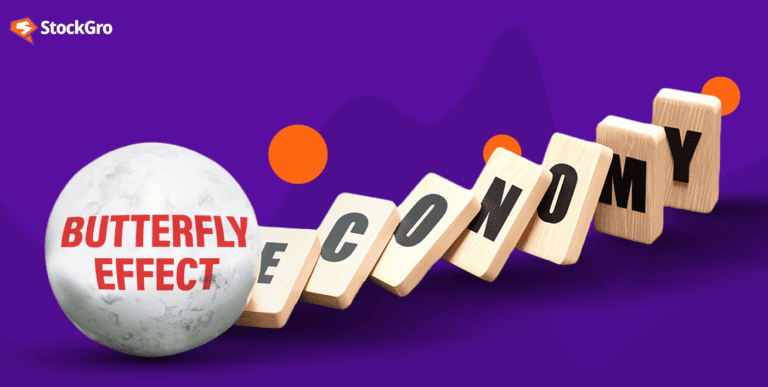
Remember in 2008, when global markets crashed? But some in Dalal Street barely flinched. Their secret? ‘Hedging’. It is like a safety cushion for your cash when market surprises.
So, let’s understand what it means!
What is hedging?
Hedging is like having a backup plan, protecting against market downturns. It is not about preventing losses, but it’s about reducing the impact. Hedging is a method used to protect investments from adverse price changes strategically.
By employing specific financial instruments and strategies, one can mitigate potential losses. This approach is applicable across various assets, including stocks, currencies, and commodities.
Common hedging instruments
What is hedging in the stock market? It is fundamentally about risk reduction. With the stock market’s unpredictable nature, where prices often see-saw unexpectedly.
Hedging function by creating a counter-position through derivatives, they can offset potential losses in their primary investments.
What are derivatives?
Derivatives, in simple terms, are financial contracts. Their price fluctuates by the value of another asset – an underlying asset. In essence, a derivative is like betting on the future price of something without actually owning it. Futures, forwards, and options are the standard players in the derivatives game.
But how effective is a derivative in safeguarding your investments? This effectiveness is measured using a term called ‘delta’ or, sometimes, the hedge ratio.
In short, delta shows the change in the price of a derivative for every one rupee shift in its main asset. It’s like understanding how sensitive your car’s brakes are when you tap on them.
Here are the common forms of derivatives:
Options
Among the derivatives, options hold a special place for hedgers. An option gives the holder the right to buy or sell an asset at a set price in the future.
Say you’re investing in a company but unsure about its performance in the next six months. By purchasing a put option (a type of option that profits when the asset’s price falls), you’re cushioning yourself against potential declines in that company’s stock price.
If the stock drops, your put option can help recover some, if not all, of those losses.
To know more: How to trade in options and maximise your profit?
Futures
Futures contracts are promises to buy or sell something at a future date at an agreed price today. They’re binding contracts, meaning both parties are obligated to follow through.
Imagine you’re a manufacturer relying on raw materials whose prices fluctuate. By using futures, you can lock in a price today and eliminate the uncertainty of tomorrow’s prices. If you’re worried about prices rising, a futures contract ensures you pay today’s prices, not tomorrow’s inflated ones.
Conversely, if prices fall, you’re committed to the price in the contract. It’s a double-edged sword but provides clarity in an uncertain market.
Also read: Futures vs. Options: Differences every investor must know!
Forwards
Forwards function similarly to futures but come with a custom touch. These are private agreements between two entities to transact an asset at a specified future date for a price decided today.
Take, for instance, a wheat farmer. Upon planting in spring, he enters into a forward contract to sell his wheat at a predetermined price when it is harvested. If market prices fall or rise, the contract ensures he gets his fixed rate, protecting his income.
Best practices: Navigating hedging strategies
There are many strategies you can use to hedge. Let’s discuss a few commonly used hedging in the stock market.
Pair Trading
Pair trading is a more advanced strategy in hedge trade, yet its essence is quite simple. It involves simultaneously buying and selling two correlated securities. The goal is to capitalise on any disparity in their prices, and by doing so in a paired manner, the overall market risk is offset. It’s like seeing an opportunity in the difference between two closely related entities.
For instance, Hero Motocorp and Bajaj Auto are significant players in the 2 & 3-wheeler industry. Over time, you’ve noticed that when Hero Motocorp’s stock price shifts in a particular direction, Bajaj Auto’s stock typically follows it, given the similarities in the industry.
Now, on a certain day, Hero Motocorp’s stock price climbs by 5%. Traditionally, Bajaj Auto would also see an increase, say around 4%. But for some unforeseen reason, say, Bajaj Auto’s stock remains stagnant. This presents an opportunity.
Given the unexpected static nature of Bajaj Auto’s stock, it’s perceived as undervalued compared to Hero Motocorp’s surge. This creates an opening for traders to buy the undervalued stock (Bajaj Auto) and short the overvalued one (Hero Motocorp).
What if the entire automobile sector, or even the broader market, goes down? Both stocks might crash. But since you’re both long and short, the losses and gains offset.
Hedging in action: An example
Let’s break down how a put option can be your hedge with HDFC stock. Think of this as a mock scenario:
You decide to buy 10 shares of HDFC at a price of ₹1,653.10 each, spending a total of ₹16,531. Now, to hedge, you also buy 10 put options at a set price (or strike price) of ₹1,500 per share. The premium is ₹30 for each option and total is₹300. The expiry is set for one year. After a year, the HDFC stock price, as expected, goes down to ₹1,400 per share. Without hedging, your shares would have been ₹14,000 and make you lose ₹2,531. However, if you exercise your put options, you will be able to sell your shares for ₹1,500 per share. This will offset your losses on your shares, and you will only lose the premium you paid for the put options, which is ₹300.
The flip side: Limitations and risks of hedging
Hedging in finance protects your assets, but it comes with certain caveats.
It’s not free: Think of hedging as buying insurance. There’s a price to pay; sometimes, the costs can be higher than the benefits you gain. Whether it’s fees or other expenses, it’s essential to consider if the protection is worth the price.
The analysis isn’t always right:
Analysis plays a big role, the hedge is as efficient as your analysis. It’s possible to believe that an investment provides a perfect hedge mistakenly, but it could be affected by market forces in a similar way to your main asset.
Counterparty risks:
Engaging in hedging means entering contracts with other parties. If they don’t honour their obligations, even the best-laid hedges can fail.
Too much of a good thing:
Over-hedging is like wearing winter gear on a mildly chilly day. By protecting yourself too much, you might miss out on potential profits. Balance is key.
It’s not foolproof:
An unexpected market event or a poorly structured hedge can mean your protective measures fall short.
Capping potential gains:
While a hedge meaning is to protect you from losses, it can limit your upside. It’s a trade-off. Say, you set a price for selling a product in the future, but then the spot market price goes higher. You’re bound by your earlier agreement, leaving potential earnings on the table. Also you may lose the initial cost of the hedge.
Bottom line
Hedging helps in mitigating losses, like an umbrella on a rainy day. Although you might get a little wet, it’s better than being drenched. Hedging is similar to an umbrella in that it can’t completely control losses, but it can help reduce the pain caused by them.
Also read: Do all technical analysis tools work equally well?
It’s smart to have some protection, but nothing’s perfect. Sometimes the sun might come out, and you won’t need that umbrella. Other times, it might rain harder than you expected. Ultimately, it’s all about being prepared and making the best of whatever weather or market conditions come your way.

